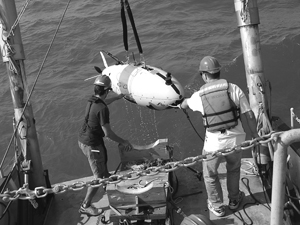
AUVs in the Heartland
by Andrea Cohen, MIT Sea GrantThe Arctic, the Antarctic, New Zealand, Italy, Greece, Wisconsin. Wisconsin? Yes, after expeditions to some of the world's more exotic locales, MIT Sea Grant's Autonomous Underwater Vehicles (AUV) Lab headed to the American Heartland for one of the first deployments of an AUV in the Great Lakes. The mission, a collaboration with the Great Lakes WATER (Wisconsin Aquatic Technology and Research) Institute, was aimed at introducing scientists to AUVs.
One of those scientists, however, needed little introduction. WATER Institute research scientist Tom Consi cut his robotic teeth at MIT, helping to develop the AUV Lab's first vehicles, and then melding his interest in robotics and biology with a small, chemical sensing AUV, Robolobster. Consi describes the collaboration as an opportunity to "acquaint our scientists with AUV technology and operational details and to inspire them to think of ways that AUVs can enhance their studies and enable new science."
Currently, the WATER Institute's standard procedures for gathering information from Lake Michigan is to deploy its research vessel, the 71-foot Neeksay, to collect water samples, use sonar, or underwater cameras. But deploying that ship is expensive, and provides only a snapshot of what's happening when the vessel is out on the lake. AUVs, conversely, offer the technology for low-cost, continuous monitoring, explains Jim Morash, MITSG research engineer. And, says, Consi, the technology allows for fish surveys, bottom surveys, geological and biological studies, as well as "studies of invasive species, especially the extent of zebra mussel and quagga mussel growth within the lake."
Employing the AUV Lab's latest vehicle, Xanthosˇoutfitted with side scan sonar and digital cameraˇMorash and AUV Lab colleagues Karl McLetchie, Dan Sura, and Rob Damus performed bottom surveys in two areas in Lake Michigan. "These locations were chosen because our scientists had extensively studied [them], and we knew what the bottom looked like," says Consi. That prior research provided independent data for checking the AUV's findings.
"The results were very good," says Consi, with one set of surveys clearly showing "the parallel rows of hills (drumlins) caused by glacial scouring when the lakes were formed 10,000 years ago." He adds: "Our scientists were quite excited by the AUV demonstration."

AUVs offer Great Lakes scientists a new way to monitor invasive species as well as conduct fish surveys and geological and biological studies.
Before that AUV mission, scientists looking at quagga mussel growth had been limited by their technology: human divers, remotely operated vehicles, and a "bottom grabber," a machine that scoops up mudˇa tricky proposition on rocky terrain and a method that doesn't provide a statistically balanced sample. With Xanthos diving up to 30 or 40 meters deep, the researchers were able to map larger areas than previously possible, in a much shorter period of time. With a sonar map and photo mosaics of the lake bottom, made possible by Xanthos, biologists were also able to better understand the variation of plant and animal types in habitats, and to get a rough count of organisms for a certain area. "That's the sort of quantitative stuff they haven't been able to do," relates Morash. "They had a picture in their minds about how they thought bottom habitat in this part of the lake was arranged geographicallyˇwhat animals they expected to find in different places," he says. The data Xanthos obtained confirmed their hypotheses. "They were very happy about that," notes Morash.
As to the difference between ocean and lake work, Morash points out that logistics are easier in the lake. "There are fewer headaches, it's a little faster getting in and out of port, and it's easier to run day [operations]," he notes. And Consi adds: "Freshwater is a lot less corrosive, so things last longer in the Lake."
Morash foresees more collaboration with the Milwaukee researchers, especially in the areas of water quality work, pollution monitoring and control. The AUV Lab is building a new sidescan camera survey vehicle with chemical sensors, which could be used for studying water chemistry. Ideally, an AUV would conduct daily chemical observations in the lake, download its data into a docking station, and recharge. This could be particularly useful after major rainstorms to better understand the mixing interface between runoff to the lake and river.
Another group at the WATER Institute hopes to use an AUV to explore the Mid-Lake Reefˇa shallow region in the center of Lake Michigan that is believed to be a sunken island. "It has species of fish that normally inhabit coastal areas but had to adapt to deeper water conditions of the sunken islandˇa very interesting and not yet studied phenomenon," says Consi. Such study, adds Morash, would also provide a physical and biological model for exploring seamount habitats in the deep ocean.
Back in Cambridge this spring, the AUV Lab members are hard at work constructing two brand new autonomous vehicles. Odyssey IV is a deep-rated (6000 meters) hover-capable AUV, designed for close inspection of cold-water coral reefs and deep archaeological sites. This new high-powered submarine will be hitting the water for the first time at the beginning of the summer. The second new vehicle under construction is a diesel-electric surface craft. This small GPS-guided vessel is designed to take water quality measurements over a wide area, and should be able to run for days at a time without stopping. As the weather warms up, the AUV engineers will also return to field work at Mystic Lake in Medford, MA, for another round of testing with their mass spectrometer AUV Kemonaut.